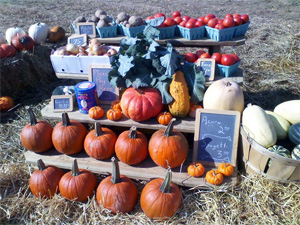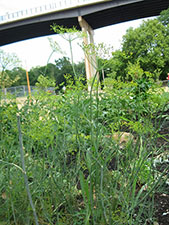
|
Preserving Farmland in Ohio
(Part Two)
By: Katie Sobiech
|
So, what do you think a park is for?
American’s in general don’t often think about parks as having any relation to food, or as places where agriculture happens.
“You go there for a picnic, a walk, to play ball, look at the scenery… You go there and come home. People don’t live there, work there and they sure don’t farm there,” Kelsey said of what parks have become.
Hale Farm and Village came about in hopes to change this by trying to re-invent the older type of farm/park. Along the way it turned into more of a display than an actual farm that produces things.
The Old Sturbridge Village in Massachusetts is one of the greatest examples Darwin knows of. It was the first living history farm in the country, and became very popular.
By the end of the 1980’s it was the model of success. Many farm/parks across the country learned from their example.
The Plan
Kelsey thought ‘There ought to be a place that really focuses on this and helps people understand how others that work with the land, plants and animals grow things on purpose to feed us’.
He presented an idea and was asked to draw up a plan.
“So we hatched this thing that we called Lake Farm Park, today it’s called Lake Metro Parks Farm Park. In my mind it was a cross between a zoo, botanical garden, history museum and science center,” Kelsey said.
It’s a place full of domestic, rather than wild, plants and animals and focuses on education.
With this came many questions for Kelsey, in re-inventing old farms.
How you rehabilitate farms? How do you recruit people to farm? How do you support them so they can create viable businesses here, and have an education program to get the public engaged with it?

Discoveries
So that’s what he set out to do.
“We discovered a lot of things as we got into it. There had been all this disappearance of farms over a period of time,” he said.
“When we got involved, one of our first jobs was to inventory the dead carcasses of old farms, and see what body parts were out there that we could stitch back together and breathe life back into,” he continued.
He explained how they looked at the “dead carcasses” of 85 old farms.
At first they thought they could save 30-35, now they’re realizing 13 is more realistic. Eleven are under management and 2 more will be operated in the future.
Darwin actually lived on a farm with his wife as it was being rehabilitated. All for the sake of inspiring people and getting them to understand where their food comes from, how it impacts their personal life, community life, and the environment.
Connecting the Dots
“Wendell Barry writes about the pattern of problems associated with modern industrial food systems. It’s (not just one thing) it’s a pattern,” Kelsey said.
“One of the things that makes us as an organization different is that we were thinking about it that way and others weren’t, and they still don’t,” he continued.
Their brochure, Connecting the Dots, goes into detail about that.
“For us the dots were farmers, farmland, food and community – all those together. Almost all the other organizations that we interact with treat one of these as a hot button issue. Some of them don’t see any of it as related to community, so when we were sorting through ‘who are we?’ ‘What’s the point of us?’ we began to say its connecting these dots, getting people to relate this whole set of things,” he said.
This is all part of a larger picture of connecting people, food and land by increasing public understanding of how food impacts personal and environmental health and by inspiring them to make a personal commitment for building a resilient, sustainable food culture.

Successes in the Movement
Overall, there has been great success in restoring local agriculture.
Kelsey has led the way in establishing 13 “rehabbed” and stable farms, now providing jobs and customers for each farm.
You can find many of these farmers at the Howe Meadow Farmer’s Markets.
Ideally, Kelsey and the many others who are part of this movement, would like to see more than just 2% of food produced and consumed locally.
What a beautiful day it will be when a larger percentage of food is produced locally, and people were more interested in purchasing it.
Though the numbers are currently low, CVCC is off to a great start at building it back up.
Final Thoughts
“If I have a hero in the local food movement it’s probably John Ikerd. He’s written some really wonderful things,” Kelsey shared.
Two of the big questions that come up are how you get people to get involved? And how do you measure change?
“Ikerd says, and I pretty much believe, that people don’t make major changes in their lives unless 3 things happen: one, they don’t believe that the current system is working, two they don’t think it’s going to work in the future and 3 they have a pretty clear idea of what an alternative would be,” Kelsey shared.
(Ikerd’s personal website: www.johnikerd.com)
Getting an understanding of the current system and how it’s not working, and seeing how wonderfully an alternative system could be is what can promote change in our lifestyles.
The CVCC continues their work to inspire, educate and help those who want to build and give momentum to this movement.
For more information on how you can be a part of this please visit: www.cvcountryside.org. You may also like to visit farmer and author Wendell Berry’s website at www.wendellberrybooks.com
If you have any story ideas, questions, or comments you can contact: Katie@akroneur.com.